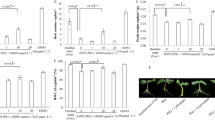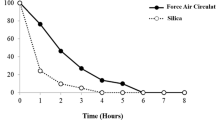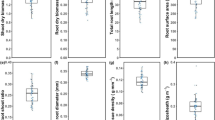Abstract
The effect of iron deficiency, phosphorus, NaHCO3, chelator supply and nitrogen source on the formation of cluster (proteoid) roots was investigated in Casuarina glauca growing in water culture. The addition of iron-binding chelators (e.g. EDDHA, DTPA, EDTA) or increase in nutrient solution pH with NaHCO3 resulted in the formation of cluster roots when plants were grown in solution lacking iron. Phosphorus supply even at a concentration of 500 µM did not inhibit cluster root formation if EDDHA was added to the iron-deficient medium. Cluster root formation was influenced significantly by nitrogen source and occurred only in nitrate-fed plants.
C. glauca seemed to be very sensitive to iron deficiency as shown by plant chlorosis when grown on alkaline soil. The symptoms of chlorosis decreased as the chlorophyll content in shoots and the number of cluster roots increased, suggesting that the alleviation of iron deficiency in plant tissues was correlated with cluster root formation. It appears that iron deficiency is more important than phosphorus deficiency in inducing the formation of cluster roots in C. glauca.
Similar content being viewed by others
References
Berliner R and Torrey J G 1989 On tripartite Frankia-mycorrhizal associations in the Myricaceae. Can. J. Bot. 67, 1708–1712.
Broughton W T and Dilworth M J 1971 Control of leghaemoglobin synthesis in snake beans. Biochem. J. 125, 1075–1080.
Bruinsma J 1963 The quantitative analysis of chlorophylls a and b in plant extracts. Photochem. Photobiol. 2, 241–249.
Champagnol F 1984 Troubles de la nutrition minèrale de la vigne. In Eléments de Physiologie de la Vigne et de Viticulture Générale. pp 174–198. Champagnol Publisher, Montpellier, France.
Crocker L J and Schwintzer C R 1993 Factors affecting formation of cluster roots in Myrica gale seedlings in water culture. Plant Soil 152, 287–298.
Crocker L J and Schwintzer C R 1994 Soil conditions affect the occurrence of cluster roots in Myrica gale L. in the field. Soil Biol. Biochem. 26, 615–622.
Diem H G and Dommergues Y R 1990 Current and potential uses and management of Casuarinaceae in the tropics and subtropics. In The Biology of Frankia and Actinorhizal Plants. Eds. C R Schwintzer and D J Tjepkema. pp 317–342. Academic Press, San Diego, California.
Diem H G and Gauthier D 1982 Effet de l'infection endomycorhizienne (Glomus mosseae) sur la nodulation et la croissance de Casuarina equisetifolia. Seances Acad. Sci., Ser. C 294, 215– 218.
Diem H G, Gueye I, Gianinazzi-Pearson V, Fortin J A and Dommergues Y R 1981 Ecology of VA mycorrhizae in the tropics: the semi-aride zone of Senegal. Acta Oecologica Oecol. Plant 2, 53–62.
Dinkelaker B, Römheld V and Marschner H 1989 Citric acid excretion and precipitation of calcium citrate in the rhizosphere of white lupin (Lupinus albus L.). Plant Cell Environ. 12, 285–292.
El-Lakany M H 1983 A review of breeding drought resistant Casuarina for shelterbelt establishment in arid region with special reference to Egypt. For. Col. Manage. 6, 129–137.
El-Lakany M H and Luard E J 1982 Comparative salt tolerance of selected Casuarina species. Aust. For. Res. 13, 11–20.
Gardner W K, Barber D A and Parbery D G 1983 The acquisition of phosphorus by Lupinus albus L. III. The probable mechanism by which phosphorus movement in the soil/root interface is enhanced. Plant Soil 70, 107–124.
Gardner W K, Parbery D G and Barber D A 1982 The acquisition of phosphorus by Lupinus albus L. I. Some characteristics of the soil/root interface. Plant Soil 68, 19–32.
Jeschke W D and Pate J S 1995 Mineral nutrition and transport in xylem and phloem of Banksia prionotes (Proteaceae), a tree with dimorphic root morphology. J. Exp. Bot. 46, 895–905.
Johnson CM and Ulrich A 1959 Analytical methods for use in plant analysis. Bull. Calif. Agric. Exp. Stn. No. 766.
Johnson J F, Allan D L and Vance C P 1994 Phosphorus stressinduced proteoid roots show altered metabolism in Lupinus albus. Plant Physiol. 104, 657–665.
Lamont B B 1977 Proteoid roots. Aust. Plants 9, 259–261.
Lamont B B 1982 Mechanisms for enhancing nutrient uptake in plants, with particular reference to Mediterranean South Africa and western Australia. Bot. Rev. 48, 597–689.
Lamont BB 1993 Why are hairy root clusters so abundant in the most nutrient-impoverished soils of Australia? Plant Soil 155/156, 269–272.
Louis I, Racette S and Torrey J G 1990. Occurrence of cluster roots on Myrica cerifera (Myricaceae) in water culture in relation to phosphorus nutrition. New Phytol. 115, 311–317.
Marschner H, Römheld V and Cakmak I 1987 Root-induced changes of nutrient availability in the rhizosphere. J. Amer. Soc. Hort. Sci. 115, 589–592.
Marschner H, Römheld V, Horst W J and Martin P 1986 Root induced changes in the rhizosphere: Importance for the mineral nutrition of plants. Z. Pflanzenernaehr. Bodenk. 149, 441–456.
Marschner H, Treeby M and Rmheld V 1989 Role of root-induced changes in the rhizosphere for iron acquisition in higher plants. Z. Pflanzenernähr. Bodenk. 152, 197–204.
Mengel K 1995 Iron availability in plants tissues-iron chlorosis on calcareous soils. In Iron Nutrition in Soils and Plants. Ed. J Abadia. pp 389–397. Kluwer Academic Publishers, Netherlands.
Mengel K, Breininger M and Bübl W 1984 Bicarbonate, the most important factor inducing iron chlorosis in vine grapes on calcareous soils. Plant Soil 81, 333–344.
National Research Council 1984 Casuarinas: Nitrogen-fixing Trees for Adverse Sites. Natl. Acad. Press, Washington, D.C.
Purnell H M 1960 Studies of the family Proteaceae. I. Anatomy and morphology of roots of some Victorian species. Aust. J. Bot. 8, 38–50.
Racette S, Louis S and Torrey J G 1990 Cluster root formation by Gymnostoma papuanum (Casuarinaceae) in relation to aeration and mineral nutrient availability in water culture. Can. J. Bot. 68, 2564–2570.
Raman N and Elumali S 1992 Influence of phosphorus on cluster root formation by Casuarina equisetifolia in water culture. Indian J. Exp. Biol. 30, 928–929.
Reddell P, Bowen G D and Robson A D 1986 Nodulation of Casuarinaceae in relation to host species and soil properties. Aust. J. Bot. 34, 435–444.
Rosenfield C L, Reed D W and Kent M W 1991 Dependency of iron reduction on development of a unique root morphology in Ficus benjamina L. Plant Physiol. 95, 1120–1124.
Sanginga N, Danso S K A and Bowen G D 1989 Nodulation and growth response of Allocasuarina and Casuarina species to phosphorus fertilization. Plant Soil 118, 125–132.
SAS Institute, Inc. 1985 SAS user's guide: statistics. SAS Institute, Inc., Cary, N.C.
Silvester W B 1977 Dinitrogen fixation by plant associations excluding legumes. In A Treatise on Dinitrogen Fixation. Eds. R W F Hardy and A H Gibson. pp 141–190. John Wiley, New York.
Tang C, Buirchell B J, Longnecker N E and Robson A D 1993 Variation in the growth of lupin species and genotypes on alkaline soil. Plant Soil 155/156, 513–516.
Thoen D, Sougoufara B and Dommergues Y 1990 In vitro mycorrhization of Casuarina and Allocasuarina species by Pysolithus isolates. Can. J. Bot. 68, 2537–2542.
Trinick M J 1977 Vesicular-arbuscular infection and soil phosphorus utilization in Lupinus spp. New Phytol. 78, 297–304.
Vasanthakerishna M and Bagyaraj DJ 1993 Selection of efficient VA mycorrhizal fungi for inoculating Casuarina equisetifolia. Arid Soil Res. Rehab. 7, 177–180.
Walker R B, Chowdappa P and Gessel S P 1993 Major-element deficiencies in Casuarina equisetifolia. Fertil. Res. 34, 127–133.
White P F and Robson A D 1989 Rhizosphere acidification and Fe3+ reduction in lupins and peas: Iron deficiency in lupines is not due to a poor capacity to reduce Fe3+. Plant Soil 119, 163–175.
Yang Y 1995 The effect of phosphorus on nodule formation and function in the Casuarina-Frankia symbiosis. Plant Soil 176, 161–169.
Author information
Authors and Affiliations
Rights and permissions
About this article
Cite this article
Arahou, M., Diem, H. Iron deficiency induces cluster (proteoid) root formation in Casuarina glauca. Plant and Soil 196, 71–79 (1997). https://doi.org/10.1023/A:1004268825395
Issue Date:
DOI: https://doi.org/10.1023/A:1004268825395




